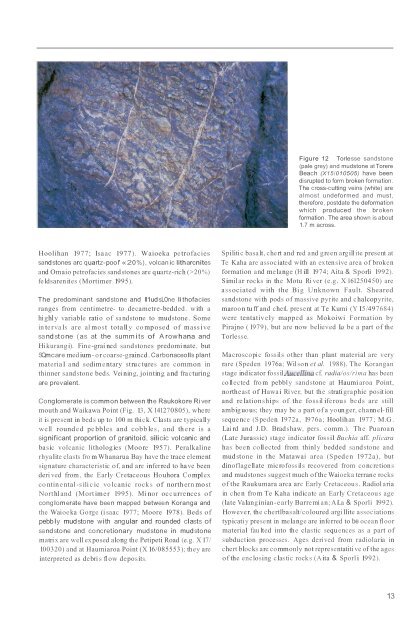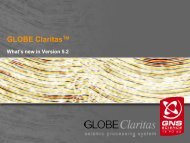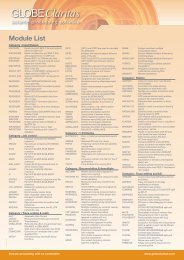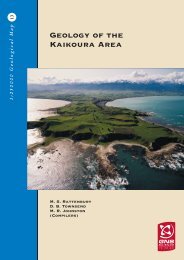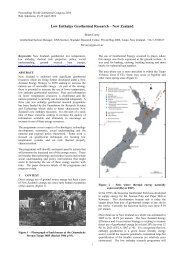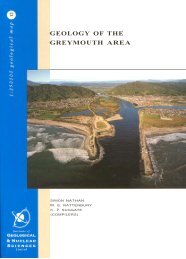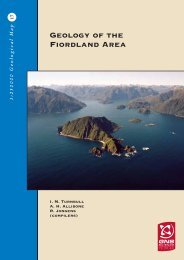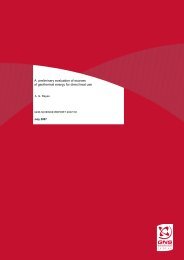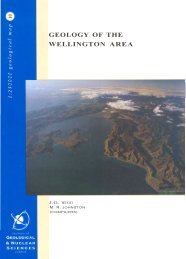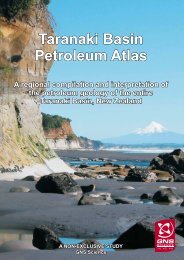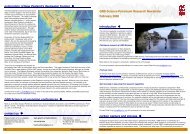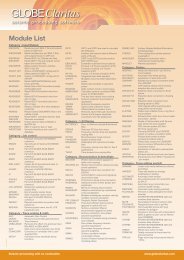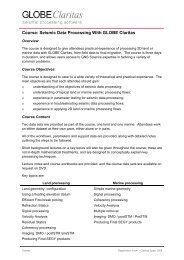GEOLOGY OF THE - GNS Science
GEOLOGY OF THE - GNS Science
GEOLOGY OF THE - GNS Science
Create successful ePaper yourself
Turn your PDF publications into a flip-book with our unique Google optimized e-Paper software.
Figure 12 Torlesse sandstone(pale grey) and mudstone at TorereBeach (X15/010505) have beendisrupted to form broken formation.The cross-cutting veins (white) arealmost undeformed and must,therefore, postdate the deformationwhich produced the brokenformation. The area shown is about1.7 m across.Hoolihan 1977; Isaac 1977). Waioeka petrofaciessandstones arc quartz-pool' «20%), volcanic litharcnitesand Omaio petrofacies sandstones are quartz-rich (>20%)fe ldsaren ites (Mortimer 1995).The predominant sandstone and ll1udsLOne lithofaciesranges from centimetre- to decametre-bedded. with ahighly variable ratio of sandstone to mudstone. Somein tervals are al most totall y composed of massivesa ndstone (as at the summ its of A rowhana andHi.kurangi). Fine-grai ned sandstones predominate, butSQmcare medium- or coarse-graincd. Carbonaceolls plantmaterial and sedimentary stru ctures are common inthinner sandstone beds. Vei ning, jointing and fracturingare prevalent.Conglomerate is common between the Raukokore Rivermouth and Waikawa Point (Fig. 13, X 141270805), whereit is present in beds up to 100 m thick. C lasts are typicallywell rounded pe bbles and cobbles, and th ere is asignificant proportion of granitoid, silicic volcanic andbasic volcanic lithologies (Moore 1957). Peralkalinerhyalite clasts fro m Whanarua Bay have the trace elementsignature characteristic of, and are inferred to have beenderi ved from, the Early Cretaceous Houhora Complexcontinental-sili c ic volcanic rocks of northern mostNorthl and (Mortimer 1995). Mi nor occurrences ofcong lomerate have been mapped between Koranga andthe Waioeka Gorge (i saac 1977; Moore 1978). Beds ofpebb ly mudstone with angular and rounded clasts ofsandstone and concretionary mudstone in mudstonematri x are well exposed along the Petipeti Road (e.g. X 17/100320) and at Haumiaroa Point (X 16/085553); they areinterpreted as debri s fl ow deposits.Spilitic basalt, che rt and red and green argill ite present atTe Kaha are associated with an extensive area of brokenformation and melange (H ill 1974; Aita & Sporli 1992).Similar rocks in the Motu Ri ver (e.g. X 161250450) areassociated with the Big Unknown Fault. Shearedsandstone wi th pods of massive pyrite and chalcopyrite,maroon tu ff and cherL present at Te Kumi (Y I5/497684)were tentatively mapped as Mokoiwi Formation byPirajno ( 1979), but are now believed Lo be a part of theTorlesse.Macroscopic fossils other than plant material are veryrare (Speden 1976a; Wilson et al. 1988). The Koranganstage ind icator fossil Alu.:ellina cf. radia/os/rima has beenco llected fro m pebbly sandstone at Haumiaroa Point,northeast of Hawai Ri ve r, but the stratigraphic positionand re lationships of the fossil iferous beds are stillambiguous; they may be a part ofa younger, channel-fillsequence (Speden I972a, 1976a; Hoolihan 1977; M.G.Lai rd and J.D. Bradshaw, pers. comm.). The Puaroan(Late Jurassic) stage indicator fossil Buchia aff. plicarahas been collected from thinly bedded sandstone andmudstone in the Matawai area (Speden I972a), butdinoflagellate microfoss ils recovered from concretionsand mudstones suggest much ofthe Waioeka terrane rocksof the Raukumara area are Early Cretaceous. Radiolariain chen from Te Kaha indicate an Early Cretaceous age(late Valanginian-early Barremi an; A iLa & Sporli 1992).However, the chertlbasalt/coloured argi llite associationstypicatiy present in melange are inferred to be ocean fl oormaterial fau lted into the clastic sequences as a part ofsubduction processes. Ages deri ved from radiolaria inchert blocks are commonly not representatiti ve of the agesof the enclosing clastic rocks (Aita & Sporli 1992).13


